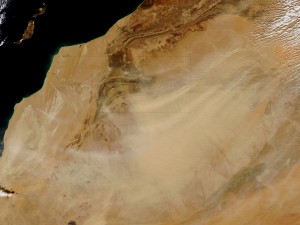
It's March 1, which means Northern California is past its driest January-February period on record. Of course, the long-range forecast looks dry, too. So our question, as state water officials report on a Sierra snowpack that has fallen far short of normal for this time of year: "Where's our rain?"
OK--we don't know the answer to that one. But there's some surprising research out on where our rain and snowfall come from.
A study from a team lead by scientists from UC San Diego and the National Oceanic and Atmospheric Administration and published yesterday in the journal Science finds that dust and "biological aerosols" from Asian and African deserts play an important role in bringing snow and rain to California. (What's a biological aerosol? A writeup on the study from the site Science Codex says "aerosols can be composed of sea salt, bits of soot and other pollution, or biological material. Bacteria, viruses, pollen, and plants, of both terrestrial and marine origin, also add to the mix of aerosols making the transcontinental voyage.")
In short, the tiny bits of matter swept up by the winds swirling across the immense stretches of desert on the other side of the world ride high-altitude winds and eventually form the nuclei of ice crystals that in turn trigger snow and rain over California and elsewhere in the western United States.
Bettina Boxall of the Los Angeles Times says the research suggests a climate mechanism that could have a major impact on California's water supply as Earth's climate undergoes warming:
"I think it has huge implications," said Guido Franco of the California Energy Commission, which funded the program. "It may counteract some of the effects of a warming climate."
Scientists predict that, in general, Earth's wet regions will become wetter with global warming and dry regions will become drier. That could mean more windblown desert dust in the atmosphere and, if the Sierra results bear out, more precipitation in the Northern California mountains that provide the state with roughly a third of its water supply.
Marshall Shepherd, a University of Georgia research meteorologist and president of the American Meteorological Society, was not prepared to go that far. "I don't know if we can make that leap yet and say that [more dust] is going to lead to large global changes in precipitation patterns," Shepherd said. "There are so many other competing factors."
The research was part of a three-year project called CalWater, a joint effort by UC-San Diego's Scripps Institution of Oceanography, NOAA, and the California Energy Commission.